Sperm Whales: Masters of Deep Sea Exploration and Survival
Written on
The Marvels of Sperm Whales
Sperm whales are often mistaken for submarines, a fact that emphasizes their remarkable adaptations as deep-sea mammals. During World War II, there were even guides created to help distinguish between these majestic creatures and enemy subs, leading to unfortunate incidents where submarines accidentally harmed whales. Thankfully, advancements in technology have largely prevented such occurrences today.
The astonishing diving abilities of sperm whales would likely astound even the likes of Charles Darwin. While floating in the crystal-clear waters near Bermuda, I attempted to retrieve a beautiful shell resting on the ocean floor at a depth of 25–35 meters. As a Division 1 swimmer with exceptional lung capacity, I naively assumed this task would be effortless. However, after three attempts and nearly blacking out on my ascent, I realized just how challenging deep dives can be.
It's essential to remember that as one descends, lung capacity diminishes, leading to quicker depletion of oxygen reserves. This highlights the extraordinary nature of the freediving world record of 128 meters, a feat that remains perilous even with medical supervision. In contrast, sperm whales can plunge over 2000 meters and remain submerged for up to 90 minutes, defying the very principles of mammalian biology.
Understanding the Biology of Descent
Sperm whales possess the largest brain of any known species, a significant portion of which is dedicated to echolocation. Their large heads contain a waxy substance called spermaceti, which plays a crucial role in their diving abilities.
When descending, sperm whales can regulate blood flow to the spermaceti, causing it to solidify into a heavy mass that aids in sinking effortlessly. As they dive deeper, their fins can tuck into their bodies, transforming them into hydrodynamic forms, reminiscent of submarines.
Imagine a 90,000-pound creature navigating through the darkness of the deep ocean, where light barely penetrates beyond a few hundred meters. As it descends, the surrounding water becomes increasingly oppressive, creating an environment where the whale must rely on sonar clicks to detect other marine life.
Section 2.1: Adapting to Pressure
Any creature with air-filled cavities feels immense pressure during deep dives. Sperm whales have evolved a flexible ribcage and collapsible lungs that shrink to less than 10% of their original size without sustaining injury. Their unique rib structure allows their thoracic cavity to compress, preventing damage that would occur in humans at much shallower depths.
Subsection 2.1.1: Mastering Oxygen Conservation
Top freedivers are renowned for reducing their heart rates to as low as 25 beats per minute, a natural response known as the mammalian diving reflex. Sperm whales take this adaptation to an extreme, often lowering their heart rates to single digits while submerged. This adaptation ensures that vital organs receive the oxygen they need, while non-essential functions are minimized.
The blood and muscle tissues of sperm whales contain ten times the oxygen that human bodies can hold, which is why their tissues appear darker. This unique biology allows them to utilize these oxygen reserves during their lengthy dives.
Section 2.2: Recovery Mechanisms
After surfacing, sperm whales engage in a process called reperfusion, characterized by rapid, deep breaths that restore oxygen levels throughout their bodies. Remarkably, their extremities can endure prolonged periods without oxygen, a situation that would typically lead to tissue necrosis in humans. This adaptation allows them to recover effectively after dives, showcasing their incredible resilience.
The Remarkable Evolution of Sperm Whales
What fascinates me most about sperm whales isn't just their incredible diving abilities, but the evolutionary journey that led to such adaptations. At some point, these whales discovered that calorie-rich prey was located deep in the ocean, prompting them to evolve.
Scientists observe a phenomenon called deep-sea gigantism, where invertebrates in the deep sea grow larger than their shallow-water counterparts. The reasons for this are still unclear, but theories suggest it relates to factors such as colder temperatures and reduced predation.

Giant squids, a prized prey of sperm whales, often lead to conflict. As sperm whales age, they accumulate scars on their foreheads from encounters with these formidable creatures.

Through natural selection, sperm whales have evolved to thrive in environments that would be inhospitable to most species. Their adaptations enable them to hunt for food in the depths of the ocean, showcasing the wonders of evolution and survival.

Join the ranks of over 10,000 subscribers to my newsletter for more enlightening content.